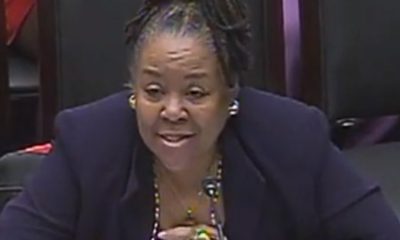Commentary
COMMENTARY: Black Tech Genius Is All Around Us
THE AFRO — Black genius is all around us. It is inescapable. We see it in our neighborhoods. We see it in our schools. We see it in our churches.
Black genius is all around us. It is inescapable. We see it in our neighborhoods. We see it in our schools. We see it in our churches. Black genius is sitting at the dinner table in plain sight.
You know those shows you like to binge watch and those GIFS we all can’t live without? We wouldn’t have them without the pioneering work of a Black woman named, Lisa Gelobter.
With her own personal flavor of Black girl magic and a degree in computer science from Brown University, Gelobter has completely changed the way information and entertainment are produced and consumed around the world.
You can also thank a Black man by the name of Mark E. Dean for being able to watch GIFs and videos in color. In addition to leading the team that designed IBM’s first personal computer, Dean created the first color computer monitor. With a degree in engineering from the University of Tennessee, Dean took the digital age from black and white to full color.
And did you know that before Bill Gates, Africa had Philip Emeagwali? Originally from Nigeria, Emeagwali moved to the United States where he obtained a B.A. degree from the University of Oregon and earned two Master’s degrees from schools in Washington, D.C. While this Black genius is known as the “Bill Gates of Africa,” it wasn’t Gates who developed
the world’s first supercomputer – it was Emeagwali.
Black genius is not just now guiding us into the future of technology – it has been the future for a while.
So, it’s no surprise that the next great tech hub in the United States is being built in an area with one of the largest concentrations of Black communities and Black talent in the nation.
Amazon should recognize this as it begins to build its HQ2 in Crystal City, Virginia, just a river jump away from the nation’s capital.
Washington, D.C. is the “East Coast” answer to the “West Coast” Silicon Valley. We’ve watched D.C. steadily emerge into a well-known incubator of start-ups. From federally funded IT and defense projects to major innovation sector titans like Amazon who are pitching tents throughout the region: D.C., Maryland and Virginia (or “#DMV” as it’s affectionately known) has evolved into a region also defined by tech giant HQs in Northern Virginia to the biotechnology laboratories extending from Montgomery County to Baltimore.
This should sound like great news for Black folks in the DMV area, a region that is nearly 30 percent Black in population composition. Washington, D.C. itself is just barely majority Black at 48 percent of the city-wide population and neighboring Prince George’s County (Maryland’s second largest) is nearly three quarters Black. Baltimore, Maryland is also a majority African-American city. And as the region’s technology corridor grows, so do parallel efforts from school systems and area universities (some of the top in the world) to produce more graduates with “STEM” (science, technology, engineering and mathematics) degrees.
Yet, the entire National Capital region still suffers from high Black unemployment rates and low wages.
What could easily solve this problem? Obviously, the burgeoning tech industry in the region. Still, for a number of reasons, the tech industry hasn’t yet received the message that there is a deep well of Black digital genius ready and waiting to take on these roles.
Let me take a minute to boast Howard University, my Alma Mater. Howard University is an innovative leader in STEM fields. Howard is a top producer of undergraduate African American students who eventually earn a Ph.D. in STEM-oriented subjects. Let that sink in!
As D.C.-area WTOP News recently reported, “Information Technology (IT) professionals can write their own ticket right now, with a nagging shortage of talent restricting U.S. information technology job growth despite high demand.”
According to the WTOP report, Mark Roberts, CEO of TechServe Alliance, blames the country’s inability to fill IT jobs on a lack of talent-supply in STEM fields. He is quoted as saying, “Despite robust demand in many IT skill sets, we simply do not have enough qualified IT professionals.”
Really? Something’s not adding up. Especially when Amazon will need 50,000 more of those professionals.
If there is high unemployment in, for example, D.C.’s Black community – where the Black jobless rate, according to the D.C. Fiscal Policy Center, is nearly five times the national rate at 14 percent – then that should naturally match high demand for IT employees. Why isn’t Black talent being tapped to cross this bridge?
Complaints of a “shortage” suggest that while the area is flooded with Black folks looking for employment opportunities, they don’t have the proper training required to access those opportunities. In other words, the tech corridor has an education pipeline problem.
In a U.S. News ranking of the best STEM high schools in the United States, Maryland boasted 9 of them. Still, these schools aren’t opening doors for Black students as much as they could. Of the 13,761 students afforded the opportunity to attend one of these nine schools, only 1,218 are Black. Maryland’s Black population is nearly 35 percent, including
a massive presence of African and Caribbean migrants. But the Black population of the top STEM schools in Maryland is less than 9 percent.
There’s your pipeline problem.
To access positions in STEM fields through the National Capital region, “talent” must be formally trained and certified. This usually comes from accredited colleges and universities. If there is a lack of trained professionals available in STEM fields, it would follow that there was a lack of people interested in being trained in those fields.
But a closer look at institutions – such as the University of Maryland, for example – proves that there is an abundance of interest in advanced STEM degrees. In fact, there is so much interest the university has employed questionable gatekeeping methods on their graduate programs to ensure that people are actively fenced out.
According to the University, “Certain majors are very popular and require a limit on the number of students they can accommodate and are designated Limited Enrollment Programs (LEP). Students in an LEP major must successfully complete a specific set of courses, or ‘gateway’ requirements by the semester in which they earn 45 credits.” Computer Science and Engineering are both LEP programs.
That is why it’s now, more than ever, crucial for regional Black communities to develop creative ways to circumvent the clogged tech sector pipeline. Especially with Amazon’s HQ2 on the way. While encouraging industries, policymakers and academic institutions to recognize the diverse talent and potential employment pool they’re overlooking, we also need to mold and strengthen our own community organizations, religious institutions and schools (from K-12 to regional HBCUs) to fill these voids left open by systemic ignorance.
There is no shortage – only a lack of will and vision. The gateway is blocking Black talent access into places like the DMV corridor. There isn’t a gap between talent and the tech industry – there is a fence. And it’s time we stop it from keeping Black genius out.
Ateya Ball-Lacy is founder/executive director of Hood Smart: The UrbanSTEMulus Project, a dynamic DC-based program that promotes increased STEAM education for Black youth in the region.
This article originally appeared in The Afro.
Commentary
Opinion: Lessons for Current Student Protesters From a San Francisco State Strike Veteran
How the nation’s first College of Ethnic studies came about, bringing together Latino, African American and Asian American disciplines may offer some clues as to how to ease the current turmoil on American college campuses over the Israel-Hamas war. After the deadline passed to end the Columbia University encampment by 2 p.m. Monday, student protesters blockaded and occupied Hamilton Hall in a symbolic move early Tuesday morning. Protesters did the same in 1968.

By Emil Guillermo
How the nation’s first College of Ethnic studies came about, bringing together Latino, African American and Asian American disciplines may offer some clues as to how to ease the current turmoil on American college campuses over the Israel-Hamas war.
After the deadline passed to end the Columbia University encampment by 2 p.m. Monday, student protesters blockaded and occupied Hamilton Hall in a symbolic move early Tuesday morning.
Protesters did the same in 1968.
That made me think of San Francisco State University, 1968.
The news was filled with call backs to practically every student protest in the past six decades as arrests mounted into hundreds on nearly two dozen campuses around the country.
In 1970, the protests at Kent State were over the Vietnam War. Ohio National Guardsmen came in, opened fire, and killed four students.
Less than two weeks later that year, civil rights activists outside a dormitory at Jackson State were confronted by armed police. Two African American students were killed, twelve injured.
But again, I didn’t hear anyone mention San Francisco State University, 1968.
That protest addressed all the issues of the day and more. The student strike at SFSU was against the Vietnam war.
That final goal was eventually achieved, but there was violence, sparked mostly by “outside agitators,” who were confronted by police.
“People used the term ‘off the pigs’ but it was more rally rhetoric than a call to action (to actually kill police),” said Daniel Phil Gonzales, who was one of the strikers in 1968.
Gonzales, known as the go-to resource among Filipino American scholars for decades, went on to teach at what was the positive outcome of the strike, San Francisco State University’s College of Ethnic Studies. It’s believed to be the first of its kind in the nation. Gonzales recently retired after more than 50 years as professor.
As for today’s protests, Gonzales is dismayed that the students have constantly dealt with charges of antisemitism.
“It stymies conversation and encourages further polarization and the possibility of violent confrontation,” he said. “You’re going to be labeled pro-Hamas or pro-terrorist.”
That’s happening now. But we forget we are dealing not with Hamas proxies. We are dealing with students.
Gonzales said that was a key lesson at SF State’s strike. The main coalition driving the strike was aided by self-policing from inside of the movement. “That’s very difficult to maintain. Once you start this kind of activity, you don’t know who’s going to join,” he said.
Gonzales believes that in the current situation, there is a patch of humanity, common ground, where one can be both pro-Palestine and pro-Israel. He said it’s made difficult if you stand against the belligerent policies of Benjamin Netanyahu. In that case, you’re likely to be labeled antisemitic.
Despite that, Gonzales is in solidarity with the protesters and the people of Gaza, generally. Not Hamas. And he sees how most of the young people protesting are in shock at what he called the “duration of the absolute inhumane kind of persecution and prosecution of the Palestinians carried out by the Israeli government.”
As a survivor of campus protest decades ago, Gonzales offered some advice to the student protesters of 2024.
“You have to have a definable goal, but right now the path to that goal is unclear,” he said.
About the Author
Emil Guillermo is a journalist and commentator. A veteran newsman in TV and print, he is a former host of NPR’s “All Things Considered.”
Activism
Oakland Post: Week of May 1 – 7, 2024
The printed Weekly Edition of the Oakland Post: Week of May 1 – 7, 2024

To enlarge your view of this issue, use the slider, magnifying glass icon or full page icon in the lower right corner of the browser window. ![]()
Activism
Oakland Post: Week of April 24 – 30, 2024
The printed Weekly Edition of the Oakland Post: Week of April 24 – 30, 2024

To enlarge your view of this issue, use the slider, magnifying glass icon or full page icon in the lower right corner of the browser window. ![]()
-

 Community3 weeks ago
Community3 weeks agoFinancial Assistance Bill for Descendants of Enslaved Persons to Help Them Purchase, Own, or Maintain a Home
-

 Business3 weeks ago
Business3 weeks agoV.P. Kamala Harris: Americans With Criminal Records Will Soon Be Eligible for SBA Loans
-

 City Government4 days ago
City Government4 days agoCourt Throws Out Law That Allowed Californians to Build Duplexes, Triplexes and RDUs on Their Properties
-

 Activism4 weeks ago
Activism4 weeks agoOakland Post: Week of April 10 – 16, 2024
-

 Activism2 weeks ago
Activism2 weeks agoOakland Post: Week of April 24 – 30, 2024
-

 Community3 weeks ago
Community3 weeks agoAG Bonta Says Oakland School Leaders Should Comply with State Laws to Avoid ‘Disparate Harm’ When Closing or Merging Schools
-

 Community3 weeks ago
Community3 weeks agoRichmond Nonprofit Helps Ex-Felons Get Back on Their Feet
-

 Community3 weeks ago
Community3 weeks agoOakland WNBA Player to be Inducted Into Hall of Fame






















































